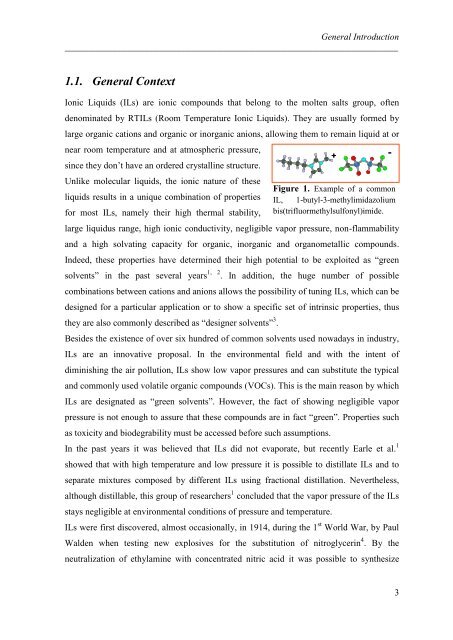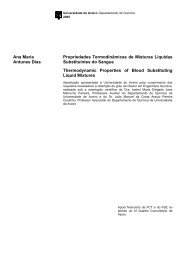Catarina Maia Seco Seiça Neves Sistemas Aquosos Bifásicos com ...
Catarina Maia Seco Seiça Neves Sistemas Aquosos Bifásicos com ...
Catarina Maia Seco Seiça Neves Sistemas Aquosos Bifásicos com ...
Create successful ePaper yourself
Turn your PDF publications into a flip-book with our unique Google optimized e-Paper software.
General Introduction<br />
_________________________________________________________________________<br />
1.1. General Context<br />
Ionic Liquids (ILs) are ionic <strong>com</strong>pounds that belong to the molten salts group, often<br />
denominated by RTILs (Room Temperature Ionic Liquids). They are usually formed by<br />
large organic cations and organic or inorganic anions, allowing them to remain liquid at or<br />
near room temperature and at atmospheric pressure,<br />
since they don’t have an ordered crystalline structure.<br />
Unlike molecular liquids, the ionic nature of these<br />
liquids results in a unique <strong>com</strong>bination of properties<br />
for most ILs, namely their high thermal stability,<br />
large liquidus range, high ionic conductivity, negligible vapor pressure, non-flammability<br />
and a high solvating capacity for organic, inorganic and organometallic <strong>com</strong>pounds.<br />
Indeed, these properties have determined their high potential to be exploited as “green<br />
solvents” in the past several years 1, 2 . In addition, the huge number of possible<br />
<strong>com</strong>binations between cations and anions allows the possibility of tuning ILs, which can be<br />
designed for a particular application or to show a specific set of intrinsic properties, thus<br />
they are also <strong>com</strong>monly described as “designer solvents” 3 .<br />
Besides the existence of over six hundred of <strong>com</strong>mon solvents used nowadays in industry,<br />
ILs are an innovative proposal. In the environmental field and with the intent of<br />
diminishing the air pollution, ILs show low vapor pressures and can substitute the typical<br />
and <strong>com</strong>monly used volatile organic <strong>com</strong>pounds (VOCs). This is the main reason by which<br />
ILs are designated as “green solvents”. However, the fact of showing negligible vapor<br />
pressure is not enough to assure that these <strong>com</strong>pounds are in fact “green”. Properties such<br />
as toxicity and biodegrability must be accessed before such assumptions.<br />
In the past years it was believed that ILs did not evaporate, but recently Earle et al. 1<br />
showed that with high temperature and low pressure it is possible to distillate ILs and to<br />
separate mixtures <strong>com</strong>posed by different ILs using fractional distillation. Nevertheless,<br />
although distillable, this group of researchers 1 concluded that the vapor pressure of the ILs<br />
stays negligible at environmental conditions of pressure and temperature.<br />
ILs were first discovered, almost occasionally, in 1914, during the 1 st World War, by Paul<br />
Walden when testing new explosives for the substitution of nitroglycerin 4 . By the<br />
neutralization of ethylamine with concentrated nitric acid it was possible to synthesize<br />
+<br />
-<br />
Figure 1. Example of a <strong>com</strong>mon<br />
IL, 1-butyl-3-methylimidazolium<br />
bis(trifluormethylsulfonyl)imide.<br />
3



